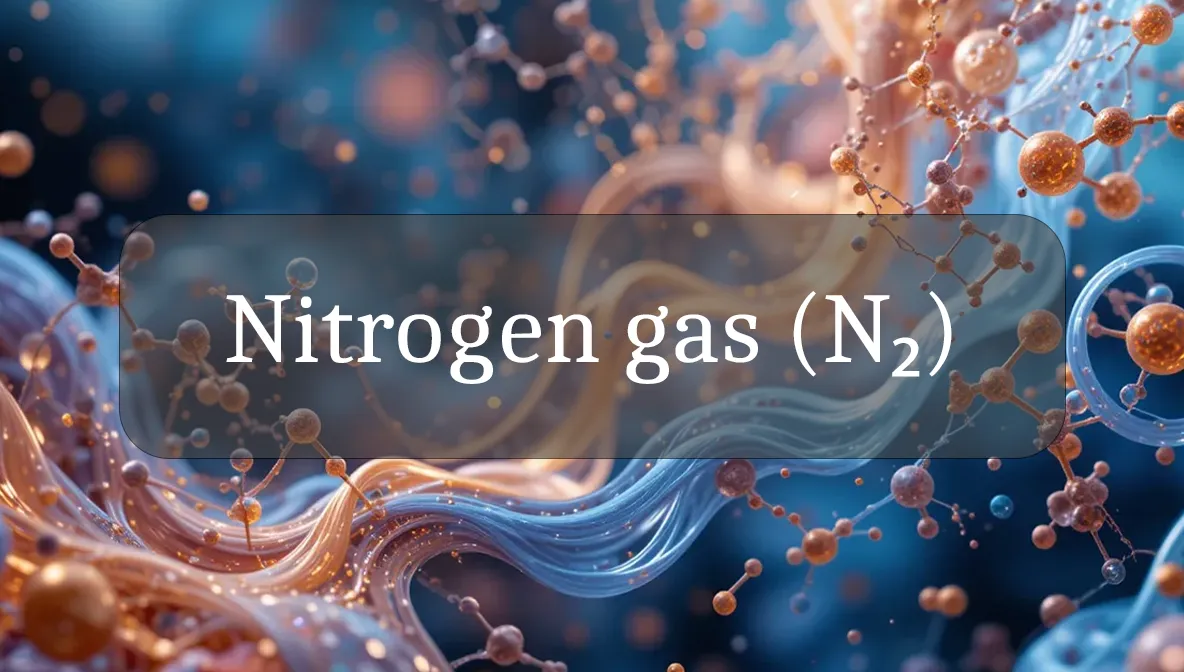Silent Supporter of Life and Health
Nitrogen gas (N₂) is all around us, making up about 78% of the air we breathe. While it’s not something we think about daily, this simple molecule plays a subtle but vital role in our health and the world we live in. For health-conscious individuals, understanding nitrogen gas can help you appreciate its quiet contributions to wellness and make informed choices about your environment and diet. Let’s explore what nitrogen gas is, its biological role, and how it connects to your everyday life in a friendly, easy-to-understand way.
Chemical Identity and Type
Nitrogen gas (N₂) is a molecule made of two nitrogen atoms tightly bonded together. It’s a colorless, odorless, tasteless gas that’s chemically stable, meaning it doesn’t easily react with other substances. As an atomic element (nitrogen) in its gaseous form, N₂ is abundant in the atmosphere but not directly used by our bodies in this state. Instead, nitrogen is critical as a building block for life, forming part of proteins, DNA, and other essential molecules when converted into usable forms like amino acids.
Biological Role and Health Impact
While we inhale nitrogen gas with every breath, our bodies don’t use N₂ directly—it’s mostly exhaled unchanged. However, nitrogen as an element is a cornerstone of health:
- Building Blocks of Life: Nitrogen is a key component of amino acids (the building blocks of proteins), DNA, and RNA, which are essential for growth, repair, and cell function.
- Supports Plant Growth: Plants rely on nitrogen (converted by bacteria into usable forms) to grow. This means the nitrogen in your food—think leafy greens, beans, or meat—starts with N₂ in the soil or air.
- Balances Oxygen in Air: By diluting oxygen in the atmosphere, N₂ prevents oxygen levels from being too high, which could lead to oxidative stress (cell damage) or fire hazards.
- Medical Uses: Liquid nitrogen (N₂ in a super-cold form) is used in medicine to freeze and remove warts, skin lesions, or preserve biological samples.
In short, nitrogen gas is like a silent partner—it doesn’t act directly in your body but supports the systems that keep you thriving.
Sources (Dietary or Environmental)
- Environmental: Nitrogen gas is everywhere in the air, making up 78% of Earth’s atmosphere. You’re breathing it right now!
- Dietary (Indirect): Nitrogen in food comes from proteins and other compounds. Good sources include:
- Meat, poultry, fish, and eggs
- Legumes (beans, lentils, peanuts)
- Nuts and seeds
- Whole grains and vegetables
- Agricultural: Nitrogen fertilizers boost crop growth, indirectly increasing the nitrogen content in plant-based foods.
While you can’t “consume” N₂ gas, eating a balanced diet rich in protein ensures you get enough nitrogen in usable forms.
Deficiency/Excess Signs
Since nitrogen gas itself isn’t used directly by the body, deficiency or excess of N₂ gas isn’t typically a health concern in everyday life. However, issues related to nitrogen can arise in specific contexts:
- Nitrogen Deficiency (Indirect):
- A diet low in protein can lead to insufficient nitrogen for building amino acids, causing muscle loss, weak hair or nails, or slow healing.
- Symptoms: Fatigue, weight loss, or weakened immunity.
- Nitrogen Excess (Rare):
- In divers, rapid decompression can cause “the bends” (decompression sickness), where dissolved N₂ forms bubbles in blood, leading to joint pain, dizziness, or serious complications.
- Overexposure to nitrogen gas in confined spaces (e.g., industrial accidents) can displace oxygen, causing asphyxiation (difficulty breathing, confusion, or fainting).
For most people, nitrogen balance is maintained through a healthy diet and normal breathing.
Supporting Optimal Levels
To ensure your body has enough nitrogen for its needs, focus on these practical steps:
- Eat Protein-Rich Foods: Include lean meats, fish, eggs, beans, or tofu in your meals to provide nitrogen for amino acids and DNA.
- Support Gut Health: A healthy gut helps absorb dietary nitrogen compounds. Eat fiber-rich foods like vegetables and whole grains to keep digestion strong.
- Stay Safe in High-Risk Settings: If you’re a diver, follow safe decompression protocols to avoid nitrogen-related issues. In industrial settings, ensure proper ventilation to prevent oxygen displacement.
- Choose Nutrient-Dense Plants: Opt for vegetables grown in nitrogen-rich soil (e.g., organic or well-fertilized crops) to maximize nutrient quality.
By maintaining a balanced diet and safe environment, you’re supporting your body’s use of nitrogen without even thinking about it!
Safety, Interactions, and Precautions
Nitrogen gas is generally safe since it’s a natural part of the air we breathe, but there are a few precautions to consider:
- Asphyxiation Risk: In enclosed spaces (e.g., labs or industrial areas), high levels of N₂ can reduce oxygen, leading to suffocation. Always ensure good ventilation in such settings.
- Diving Safety: Divers should ascend slowly to prevent decompression sickness from nitrogen bubbles forming in the blood.
- Liquid Nitrogen: Used in medical or culinary settings (e.g., freezing ice cream), liquid N₂ is extremely cold (-196°C/-321°F) and can cause severe frostbite or burns if mishandled.
- Dietary Balance: Overloading on protein to boost nitrogen intake can strain kidneys or liver in some people, so stick to recommended protein amounts (about 0.8 grams per kg of body weight daily for most adults).
For everyday life, nitrogen gas poses no risks, but awareness in specific scenarios keeps you safe.
Fun Fact
Nitrogen gas is so stable that it’s used to preserve food and prevent spoilage! Ever notice the “puffy” bags of chips? That’s nitrogen gas inside, keeping your snacks fresh by preventing oxygen from causing rancidity.
Citations
- National Institutes of Health (NIH). “Protein and Amino Acids: Role in Human Health.”
- Mayo Clinic. “Nutrition and Healthy Eating: Protein Basics.”
- World Health Organization (WHO). “Dietary Protein and Nitrogen Balance.”
- Cleveland Clinic. “Understanding Decompression Sickness in Divers.”
- USDA National Agricultural Library. “Nitrogen in Agriculture and Food Systems.”

